Roof inspections are essential for figuring out potential points and ensuring the longevity of your roof. Regular inspections might help detect issues early, stopping costly repairs or replacements down the road. Here are some common strategies and steps for conducting a roof inspection:
Visual Inspection:
a. Exterior Inspection:
Start by examining the roof from the bottom utilizing binoculars or by safely climbing onto a ladder to get a extra in-depth look.
Look for seen signs of damage, corresponding to missing or damaged shingles, curling or buckling shingles, or unfastened or deteriorated flashing around roof penetrations.
Check for particles, moss, algae, or lichen growth on the roof, which can point out moisture-related issues.
Inspect the gutters and downspouts for granules from shingles, as excessive granule loss can signal shingle wear.
b. Interior Inspection:
Go into the attic or crawl space and examine the underside of the roof deck for signs of leaks, moisture, or water stains.
Look for daylight coming by way of cracks or holes within the roof deck, which may indicate roof damage.
Check for indicators of insulation harm, mildew, or mildew growth, which might end result from roof leaks.
Roof Walk:
a. If it's protected to do so, stroll on the roof floor to inspect it up shut.
b. Be cautious and wear appropriate security gear, corresponding to non-slip sneakers and a security harness if needed.
c. Look for check here or spongy areas, which may point out underlying damage.
d. Check for unfastened or broken roofing supplies, in addition to signs of wear and tear and tear.
Moisture Detection:
a. Use a moisture meter to detect hidden moisture inside the roof construction and insulation.
b. Moisture detection can help establish leaks or areas of potential water intrusion that will not be visible.
Drone Inspection:

a. Drones outfitted with cameras can present a complete view of the roof floor with out the necessity for direct physical access.
b. A drone inspection can be particularly helpful for larger or hard-to-reach roofs.
Professional Inspection:
a. Consider hiring a professional roofing contractor or inspector to conduct a radical inspection.
b. Professionals have the expertise, tools, and expertise to identify issues that is probably not obvious to a home owner.
Documentation:
a. Document your findings with photos and notes to create a record of the roof's condition.
b. This documentation can be helpful for monitoring modifications over time and for insurance coverage claims or repairs.
It's important to perform roof inspections often, ideally a minimal of annually, and after severe weather events like storms. Additionally, should you're not comfortable or assured in your capability to carry out a roof inspection safely, it's advisable to hire a professional roofing professional to make sure an intensive and accurate assessment of your roof's situation..
